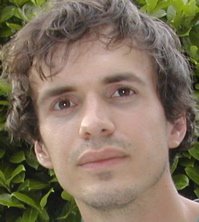Preparing for Nepal
I first went to Nepal in November and December of 2001. I'd just spent a semester studying abroad in southern India. We weren't supposed to go to Nepal-- 9/11 had just happened, the U.S. had declared war on Afghanistan, and Nepal was in a state of emergency.
We went anyway. (I went with a former girlfriend, who is still a close friend of mine.) We took a train to Darjeeling via Kolkata. Our first night in Nepal, we saw a white light hovering above the mosquito netting, and we were convinced that a spirit had joined us.
On the elephant god Ganesha's birthday a few months earlier, I'd had a strange experience where I was convinced that my bedroom in Mysore was filled with chanting monks from the Himalayas.
While trekking in the Annapurnas, I saw what looked like a portal on the shimmering face of Dhaulaghiri, and imagined that another world lay beyond it. While hiking along the Tibetan plateau, we saw a wall of caves which seemed to be inhabited by the spirits of renunciants in deep meditation.
On that same trek, we visited the eternal flame of Muktinath. Saddhus walk from the southern tip of India to see this holy place, wearing nothing but sandals and orange robes (a fact that would deeply impress any ultra-light backpacker).
During a strange and somewhat ill-fated reiki retreat in the Shivapuri Nature Retreat north of Kathmandu, we met a Nepali boy named Raju who was blind in one eye.
When I left, I knew that I wanted to return to Nepal in some deeper capacity. I wanted to give something back to the community, and I also wanted more than just a superficial understanding of Nepali culture and customs. I also wanted to deepen my own spiritual practice.
Now, with the help of a Fulbright grant, Melissa and I are headed to Kathmandu in September. I plan to learn Nepali Sign Language, to get involved in the deaf community, and to write stories and hopefully a longer work based on my experiences. Over the next few months, we will be preparing for our trip, arranging visas and vaccinations, discussing our hopes and dreams, reminding ourselves that we must be flexible and open to what our experience brings us.
Now, as then, Nepal is facing political turmoil, though the prospects seem much brighter now. The Maoists have a significant role in the government, the monarchy was recently abolished, and while the peace is tenuous, the Maoists and Royal Army are no longer engaged in a war of attrition. The new government, while bulky and bureaucratic, has one of the largest representations of minorities and women in any government.
Now, as then, Nepal remains one of the poorest countries in the world. There are only a few fragile lifelines connecting Kathmandu to the outside world. Because Nepal is mainly mountainous and there isn't enough arable farmland to sustain its growing population, it relies on food and fuel imports from India. As one of the largest sources of potential hydroelectric power in the world, Nepal is literally caught between a rock and a hard place-- both China and India would like to exploit its resources.
Kathmandu lies on one of the world's most active fault lines, and a major earthquake happens approximately every 75 years. The last one happened in 1934. I had to laugh when I added 75 onto that, since Melissa and I will be there in 2008-09. But a major earthquake in Kathmandu would be no laughing matter. The Fulbright Orientation Manual predicts that there would be tremendous loss of life, 60% of the buildings in Kathmandu would be destroyed, and bridges and roads would collapse.
Nepal remains one of the most fragile and beautiful places in the world. The streets and orphanages are full of children like Raju, and as a deaf person myself, I hope that I can provide something unique to the deaf community.
Nepal is sometimes compared to a downtrodden Shangri La, long since discovered and trampled by backpackers (going all the way back to the hippie days of Freak Street). And yet to me, Nepal is still full of beyuls, Buddhism's hidden valleys. There are still spirits in caves and portals in mountains, even as Kathmandu and the country as a whole face the pressures of the 21st century.







